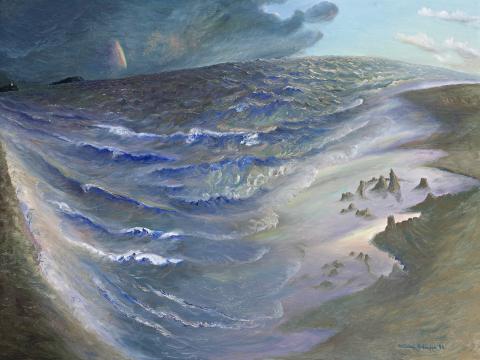CLEARING STORM TO FINGAL, 1996
WILLIAM ROBINSON
oil on canvas
76.5 x 102.0 cm
signed and dated lower right: William Robinson 96
Ray Hughes Gallery, Sydney
The Collection of Colin and Elizabeth Laverty, Sydney, acquired from the above in July 1996
William Robinson, Ray Hughes Gallery, Sydney, 28 June – 24 July 1996, cat. 11 (illus. in exhibition catalogue)
Spirit and Place – Art in Australia 1861 – 1996, Museum of Contemporary Art, Sydney, 22 November 1996 – 31 March 1997
On display, National Gallery of Australia, Canberra, 10 February – 30 August 1998
William Robinson – A Retrospective, Queensland Art Gallery, Brisbane, 31 August – 11 November 2001; then touring to: National Gallery of Australia, Canberra, 14 December 2001 – 10 March 2002 (label attached verso)
William Robinson: The Transfigured Landscape, QUT Art Museum and William Robinson Gallery, Brisbane, 16 April – 14 August 2011
Sears, L., Darkness and Light, The Art of William Robinson, Queensland Art Gallery, Brisbane, 2001, pl. 80, p. 143 (illus.)
Klepac, L., William Robinson – Paintings 1987 – 2000, The Beagle Press, Sydney, 2001, pp. 114 – 115 (illus.)
Van Ooyen, V. (et al), William Robinson: The Transfigured Landscape, Queensland University of Technology, Brisbane and Piper Press, Sydney, 2011, p. 80 (illus.)
Between 1994 and 1999 Bill and Shirley Robinson lived at Kingscliff on the northern New South Wales coast. Naturally, with his commanding view of the ocean this move heralded a major shift in Robinson’s subject. His familiar depictions of forests gave way to images of the sea, which came as an intriguing development for visitors to Robinson’s exhibitions at the Ray Hughes Gallery in Sydney. If there is a Yin and Yang to Robinson’s oeuvre, surely it is his paintings of the ocean alongside those of the Queensland landscape. While Robinson’s epic landscapes depict the ancient forests and capture the permanent, timeless nature of the ancient trees, his paintings of the coast line and oceans show the constant state of change and the ephemeral nature of the oceans moods. As Robinson explains,
‘… Living at the sea for a good part of my time gives me a chance to see the changing moods of the sea and sky. These are almost the only two elements and they interact with reflective light and powerful movement clothed in great beauty. There is a constant movement of light and form. It is a transparent painting. From a purely physical viewpoint it is not possible for this painting to exist. If it is viewed only from a logical analysis it is not possible to see it. The work must be felt as much as possible as pure sensation, as though the viewer is in the air of the work. Because of the picture plane and the dimensions and enclosure of the illusion, the composition must still exist, but somehow appear to be incidental the feeling of being one with nature’.1
The rise and fall of the tides subtly geared by the pull of the moon are the constant in nature. The relentless power of the ocean’s action humbles all before it, and none more so than an artist who attempts to capture it. Robinson is a deeply spiritual man, so it’s no surprise that his works acknowledge a greater power. The Clearing Storm depicted reminds us that a greater force is not necessarily a benevolent one, as the painting is poised between light and dark. Key to Clearing Storm to Fingal, 1996, is the series of sandcastles which are being reclaimed by the sea. These evoke a melancholy mood and a reminder that we are each at the mercy of forces beyond our control and perhaps understanding. Prehistoric in form, these children’s remnants of a day’s play now past, are a powerful inclusion within the composition. For they remind us of the transience of life and that no matter how great mans achievements may be, when faced with the power of nature they are no more that a fickle dalliance.
1. Robinson, W., in Klepac, L., William Robinson: Paintings 1987 – 2000, The Beagle Press, Sydney, 2001, p. 114
HENRY MULHOLLAND
